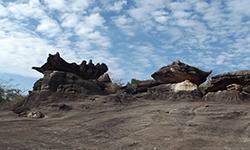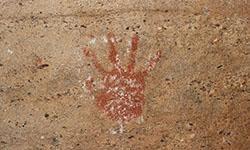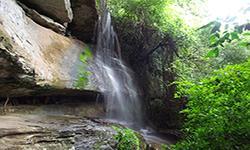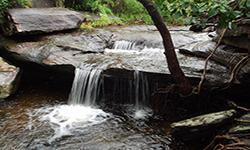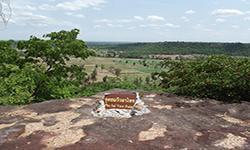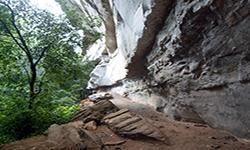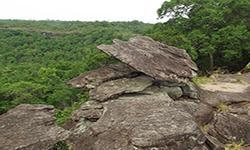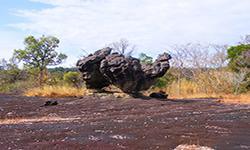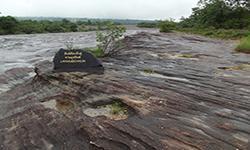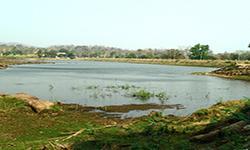Phu Pha Thoep National Park
Contact Location : Phu Pha Thoep National Park, 25 Moo.5, Ban Khon Sai, Na Si Nuan Sub-district, Mueang District, Mukdahan Province 49000
Telephone Number : (+66) 8 2107 8097
Email : Mukdahan@live.com
Facebook : Phu Pha Thoep National Park
Information
Phu Pha thoep National Park is in thearea of Mueang and Don Tan district of Mukdahan Province. There are fertile forest conditions, with deciduous dipterocarp forests on rocky grounds, or rocky Mountains. And in the rainy season, it will be filled with many kinds of beautiful flowering plants. In the mixed forests in the valleys, there are phenomenally beautiful nature such as strange shaped rock formations, caves with historical evidence, waterfalls and capillary water all year round, as well as a wide variety of wildlife. It has an area of approximately 30,312.5 rai, or 48.5 square kilometers.
Background
In 1984, the National Park Division was informed by the Mukdahan Forest Resource Management Office by the document no 009/6913 dated April 24, 1925, stating that the province was in response to the government's policy of His Excellency the Minister of Agriculture to conserve the forests near the province and its districts in the form of national parks, forest parks, or botanical gardens in order to conserve natural resources. The province has already surveyed the conditions of the areas that are suitable to be established as a national park or a forest park. The National Park Division, Royal Forest Department, issued an order No. 1260/1984 dated August 16, 1984, for Mr. Cherdchai Nilumphachat, an administrative officer 4, and Mr. Pongsak Chakkul, a forest guardian, to conduct a preliminary survey in the area of Ban Kaeng Sub-district, Don Tan District, Na Si Nuan Sub-district, Mueang District, Mukdahan Province. From the survey report, dated October 22, 1984, it appears that the areas of Phu Nang Hong, Phu Tham Phra, Phu Lang Se, Phu Hin Thoep and Phu Mano are in the Dong Bang I National Reserved Forest, covering an area of approximately 49.26 square kilometers. It is a steep continuous mountain range, consisting of mixed deciduous forest and deciduous dipterocarp forest, high cliffs, and wide and long stone terraces that are formed by
rocks of various shapes overlaid on top of each other and beautiful caves. The National Park Division had a document No. Ko So 0713/4655 dated December 11, 2527, proposing to the Royal Forest Department that the area should be established as a national park. And there was an order from the Royal Forest Department No. 1951/1984 dated December 13, 1984, for Mr. Saksit Phonsubsiri, Forest Officer 3, to proceed to establish the area as a national park. After that a document No. Ko So 0713 (Mo Ho)/1 dated January 30, 2528, reported that the survey area is appropriate to be established as a national park and assigned the National Park Division to continue the establishment. During the establishment of this national park, there were people who disagreed and opposed due to an issue of forest collecting and animal husbandry in the area, officials involved have solved such problems until they understand and then the Ban Kaeng Sub-district Council has resolved to confirm and support the government in declaring it as a national park.
Mukdahan Province presented it to the meeting of the Sub-Committee on July 22, 1987, there was a resolution to support the proclamation of a national park. The National Park Board, in a resolution at the meeting No. 1/2530 on June 18, 1987, agreed to designate the area as a national park. There is a royal decree designating the area of Dong Bang Yi Forest Land, which is in the area of Si Bun Mueang, Kham A Huan, Dong and Na Si Nuan Sub-district, Mueang District, and Ban Kang Sub-district, Don Tan District, Mukdahan Province, a National Park and announced in the Government Gazette, Volume 105, Section 235, dated December 28, 1988, is the country's 59th National Park.
Later, on May 31, 2006, the National Parks, Wildlife and Plant Conservation Department considered the name of the national park to be appropriate and consistent with the highlights and the important potential of the area, hence the Mukdahan National Park was renamed to Phu Pha Thoep National Park.
Note : After paying the entrance fee to the National Park, please carry the receipt for inspection.
30245.67 rai (48.393072 square kilometers)
|
|
|
||
|
Tham Phra Waterfall |
Wang Duean Ha Waterfall |
||
|
Pha Sai/ Lot Cave |
Pha Manao |
||
|
Pha Ngoi |
Pha Oot |
||
|
Lan Muchalin |
Huai Sing Reservoir |
||
-
Welfare shop : (drinking water, coffee, and snacks) is open daily from 8.00 - 16–.30 hrs.
Mobile phone signal :
National Park Headquarters: AIS, TRUE, DTAC
|
|
|
The terrain consists of steep continuous mountain ranges, namely Phu Nang Hong, Phu Tham Phra, Phu Lang Se, Phu Hin Thoep, Phu Mak Yang, Phu Pong, Phu Mano, and Yod Phu Chom Si is the highest peak, which is approximately at 420 meters above mean sea level. The conditions are rocky mountains,with wide and long rock slabs overlaying on one another forming various shapes, steep cliffs. The soils are sandy. It is the source of many rivers such as Ta Luek Creek, Sing Creek, Sabai Creek, Rua Creek, Bon Creek, Chang Chon Creek, Khai Creek and Male Creek etc. Geology: Phu Pha Thoep National Park is a beautiful national park and outstanding in terms of geomorphology. Most of the soils are sandy. The soil series found in the area of Phu Pha Thoep National Park include the Satuk soil series, and the Warin soil series. The general condition features Rocky Mountains interspersed with sparse forest and towering karst. The stone courtyard and the stone clusters overlaying on top of each other in different ways are beautiful scenery. Soil characteristics: The area of the Phu Pha Thoep National Park consists of 2 types of soils. First, Red Yellow Podzolic soil is formed by light-colored igneous rocks or by old alluvial deposits on the terraced plains, or in the foothills, the lower soil are red or yellow, clearly display an accumulation of clay particles, has a weak acidic reaction, a relatively low saturation value and has good drainage but relatively low fertility. Another type of soil is grain podzolic soil, very old soil, was severely eroded by water, formed by old alluvial deposits or by sandstone, coarse-grained, and low-organic, high and too highly drainage, there are minerals that are still decaying, low soil palatability, acidic reactions and low nutrients. The land of Phu Pha Thoep National Park mostly contains sandstone mountains and belongs to Khorat Group, the Sao Khua Formation, the Phra Wihan Formation, and the Phu Phan Formation. This group of rocks originated in the Mesozoic Era, aged 120-95 million years, formed by continental sediments and are widely spread in the northeastern part of Thailand, commonly known as the Khorat Plateau (the Khorat Plateau), including the Phu Pha Thoep National Park. Each formation has the following distinctive features: - The Sao Khua Formation generally features siltstone and sandstone, but mostly sandstone. Sandstone is often grayish red or reddish brown mixed with specks of greenish gray. Some layers can be grayish-green or light green. Some layers of sandstone are dull gray, similar to the colors of salt and pepper mixed together. The rest can usually be reddish-brown or yellowish-brown, purple, brown, grayish-purple, grayish purple, and reddish-brown, bright red, fine to medium-sized, loamy, can hold together well, some layers contain mica and gravel, and there are oblique layers. In general, with occasional gravel layers. - The Phra Wihan Formation is a durable group of sandstone mixed with silk stone. It also includes thick layered silt, round pebbles, and stones mixed with gravels, both durable and non-degradable to decay. It was formed during the Jurassic period. - The Phu Phan Formation is formed in the Lower Cretaceous. It is resistant to corrosion and decay naturally. Therefore, these rocks are often found in form of solid rock formations or on the peaks of the Northeastern region or on the stones in the Mekong River. Water resources: The main watershed in Phu Pha Thoep National Park is the Mun Basin. Phu Pha Thoep National Park consists of watershed class 3 which is accounting for 46.15 percent of the area of the national park, followed by watershed class 2 accounting for 41.98 percent, watershed class 1 accounting for 6.12 percent and watershed class 4 accounting for 5.7 percent. The canals within Phu Pha Thoep National Park are Li Khi Creek, Ta Lueak Creek, Sing Creek, Sai Phai Creek, Ruea Creek, Chang Chon Creek, Krai Creek, and Male Creek which receive headwater from Phu Chom Si and Phu Tham Phra, before flowing into the Mekong River. Other important surface water sources that are close to Phu Pha Thoep National Park are Huai Sing Reservoir, Huai Chang Chon Reservoir, and Huai Ruea Reservoir. |
|
The National Park's climate is divided into 3 seasons: the rainy season from June-November, winter from December-January, and summer from February-May. The forest conditions consists of deciduous dipterocarp forest covering approximately 60 percent of the area. The predominant plants in this forest are dipterocarps such as Shorea obtusa, Shorea siamensis, Hairy Keruing , Shorea roxburghii, Irvingia malayana, etc. 30% of the area is mixed deciduous forest. The predominant plants in this forest are Xylia xylocarpa, Dalbergia cochinchinensis, Burma Padauk, Afzelia xylocarpa, and Lagerstroemia calyculata , etc. 10% of the area is dry evergreen forest, withthe predominant trees including Dialium cochinchinense Pierre., Hopea ferrea Laness, Wrightia religiosa., Pink Mempat, Cratoxylum formosum. and Mitrephora tomentosa ., etc.
|
|
|
|
|
|
Most of the wildlife seen are small animals such as Wild Boars, Rabbits, Squirrels, Chipmunks, Barking Deer, Asian palm civet, Spotted Foxes, Monkeys, Wild Fowl, and a variety of birds.
|
How to get there by car :
Phu Pha Thoep National Park has well developed the route for accessibility. Visitors can travel from Bangkok using Highway No. 2 heading for Nakhon Ratchasima Province. Then enter the route number 207 passing through district Prathai, and deviate into the road number 202 heading for Amnat Charoen Town. Take the route number 212 to Mukdahan Province.
The Phu Pha Thoep National Park Headquarters is far from the district town of the province about 15 kilometers. Take highway No. 2034 Mukdahan-Don Tan. Between the milestone No.14 - 15, turn right onto a paved road and continue for about 1.4 kilometers to Phu Pha Thoep National Park.
- National Park Ranger Station Mo Ho No. 1 (Huai Sing)
- National Park Ranger Station Mo Ho No. 2 (Huai Chang Chon)
- Accommodation - Phu Pha Thoep 101 (Chan Pha)


